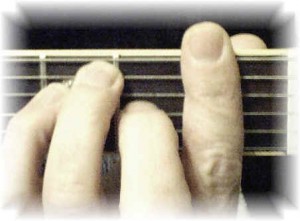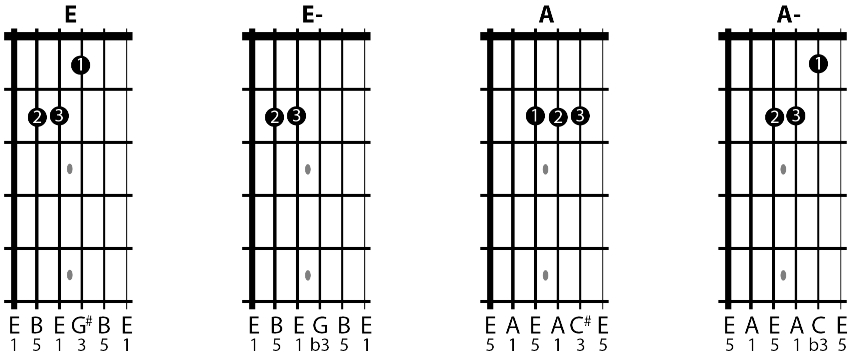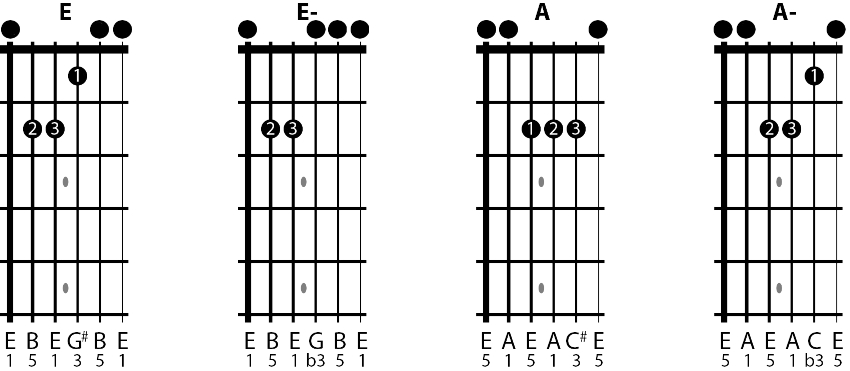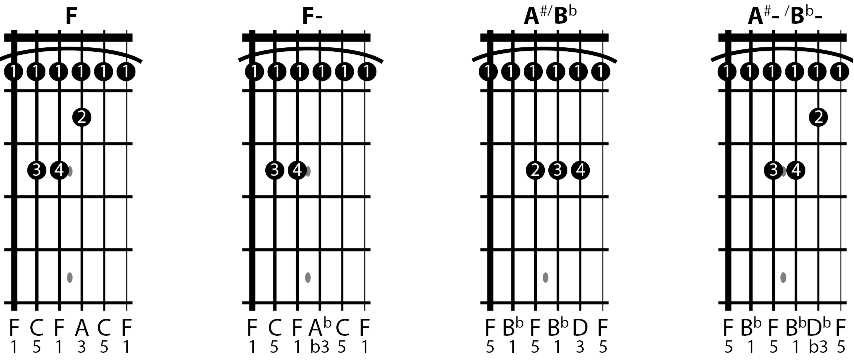To Fret Or Not To Fret (The Low E String on Bar Chords)

I wanted to write about this because this is a common, reoccurring issue with many guitar students.
Many guitar students seem to have this whole, interesting misconception, that you are are not allowed to bar the low E string on an A-shape bar chord.
What Are Bar Chords?
Following chord diagrams show the chord shapes for chords E and E- (also written as “Em”, which means “E minor”) and A and A- (Am)

The notes that make up each chord, are listed at the bottom of each diagram.
E contains the notes E, G#, and B
E- = E G B
A = A C# E
A- = A C E
The numbers underneath the chord spell out the chord degree for each note: root (1), 3rd, or 5th of the chord.
When you hit those 4 chords (E, E-, A, and A-), you always hit all 6 strings, as shown in the following diagrams.

The black dots above the nut represent open string notes.
You Hit All 6 Strings When You Play E (and E-) and A (and A-) Chords.
These notes are part of the full 6-string chord. (Meaning: even though you don’t have fingers on those strings, you hit those strings too).
When you look at the notes at the bottom of the diagrams, you can tell that these open-string notes are part of the chord. The notes produced by the open strings are the same notes as the notes that are fingered on the fret.
Example:
In the E chord: you have your first finger (the numbers in the dots) on a G# note, 3rd finger on the D strings on an E note, and 2nd finger on the A string on a B note.
The open-string notes are: an open treble and bass E (same note as we fingered on the D string), and an open B string (same note as fingered on the A string with the 2nd finger)
In other words: you can hit all 6 strings, including the open strings, on these 4 chord shapes because the open strings are tuned to the same notes as the notes you have your fingers on.
Which Leads Us To “Bar chords”!
Bar chords are the above E, E-, A, and A- chord shapes that you move up and down the fretboard barring all 6 strings with your pointy finger behind the E, E-, A, and A- shapes.
In other words: you use your index finger like a capo. (Your index replaces the guitar nut behind the chord shapes.)
Or another way to look at it: you place your index on the black open string dots (as seen in the above graphic), and then move your index finger (as a bar that you place over all strings) along with the fingers on the strings that make up the E, E-, A, and A- shapes.
Here’s how you finger bar chords:

I know so far all the above was pretty basic even for most lower intermediate guitar students.
However: there is a point I wanted to make with being so very detailed in what seems very basic guitar knowledge.
The point is following:
If it is so that you hit all 6 strings on these 4 chord shapes…
… How can so many guitar players and guitar students then have the gross misconception that you are only allowed to bar and strum 5 strings when playing an A shape bar chord???
That doesn’t make any sense, does it? 🙂
I see this happening over and over again with students.
If it’s ok to hit all 6 strings on an A chord, then it’s also ok to bar all 6 strings and hit all 6 strings on a bar chord that is an A chord with a bar behind it. (Remember: your bar is placed where you see the open string black dots above the nut on the above graphic).
I understand where that misconception comes from though!
Students who avoid the low E string on A shape bar chords must have read or heard somewhere that it’s good to have the root as the lowest note in your chord. Barring the low E string gives you the 5th of the chord as the lowest note.
However: leaving the low E string unbarred, creates extra difficulties and challenges which would be avoided if you just bar the full 6 string chord instead.
The guitarist who thinks you can’t bar the low E string on A shape bar chords often does an inadequate job of muting that low E string.
It is much preferred to have the 5th of the chord in the bass on the low E string, than to have an improperly muted low E drone as a non-chord tone, messing up the sound of your bar chords.
That low E rumble is not a very pleasant sound underneath for example a D, and Eb, a Bb, a C- or an Ab chord. (And those are not the only chords you really don’t want to mix with a low E bass)
Of course with due practice, you improve your technique to the point where muting low E strings in A shape bar chords becomes natural.
In Conclusion…
Nevertheless, whether or not you have impeccable technique and muting skills, this was directed towards guitar players who are trained to believe that you can’t bar all 6 strings on an A shape bar chord.
Now you know you can! There is nothing wrong with that.
You basically just have the 5th in the bass instead of the root, and there is nothing wrong with that.
Does it sound “better” to have the root as the lowest note?
Not if you’re accidentally hitting that open E string underneath the chord without fully muting it, while that E is not one of the notes that belong to that chord. (i.e. Eb, Bb, etc…)
Even with proper muting: “better” is in the ear of the beholder.
It just sounds (slightly) “different” to have the 5th in the bass instead of the root.
The decision between a root or a 5th in the bass would be a big deal if you wrote a string arrangement or horn section or backing vocals…
But strumming bar chords as an accompaniment to someone you’re performing or jamming with, isn’t exactly Igor Stravinsky or Beethoven, right? 🙂
(Not to mention the fact that the bass players you play with play roots, so it’s not necessary for you to play the root in the bass as well)
The gist of it all:
Yes, you can have the root as the lowest note only barring up to the A string in an A shape bar chord…
But.. don’t have misconceptions about barring the low E string on A shape bar chords: Yes you CAN do that too and no it does not sound bad to do so.
Conclusion
Hit me up anytime at vreny@zotzinmusic.com if you have any questions, or if you would like to book a lesson.
These free lessons are cool, but you will never experience the progress, joy, and results that my students experience in lessons when you’re learning by yourself from blogs and videos.
That is why people take lessons: way better results and progress, much more complete information, exposed to way more creative ideas than you can get from a blog or YouTube video.
There is only so much that self-study can accomplish.
If you want to see amazing results and progress in your guitar playing, buy your first lesson here and get started ASAP.
You’ll impress your friends and loved ones in no time with your guitar playing!
Consider donating any small amount to help me keep this blog going.
Thank you for your support!


